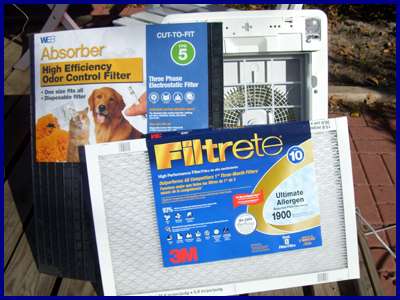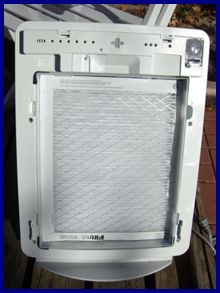Air Purifier Reviews | Reviews Air Purifiers
Re: DIY HEPA-like Replacement Filter - Do It Yourself
A Reader writes:
Hi Ed,
I purchased the Sharp Plasmacluster FPN40CX air purifier, which is (one of) the same unit as you have I believe (but mine is Canadian).
I read your email pages, but could not find an answer to my question which is; -how can I find HEPA filter material to use to replace the HEPA filter in my girlfriends FPN40CX?
I read your post on changing/replacing the carbon pellets, and will do that when the time comes.
However, the HEPA filter is getting quite black.
I know it may still be good, and it probably is due to the fact that it's only 1 year old, however the environment includes heavy smokers and cats.
That's pretty much why I bought it, so I could breath better at her place. I figure even if the filter is finished, better the black stuff in the filter, and not in my lungs...
I still see some replacement filters online, but at 80-160 bucks, it seems steep (or at the lower end, probably cheap replacement knockoffs).
There must be a way to DIY, and save money.
I tried to Google HEPA filter media but really couldn't find any online that would sell to a regular person (not in quantities of 1000 meters of the stuff).
I can't imagine that it would be that hard to cut, pleat and glue/tape in place a new HEPA filter in the plastic box that the old one is in now, I have the time/patience/will to complete such a project.
And I can't imagine it costing nearly the same $$$.
Do you have any experience or suggestions?
Also, you say that to extend the life of the HEPA, a pre-filter is good.
Now on our Sharps there is the screen pre-filter and the charcoal filter, but is that enough to extend the life of the HEPA?
Should I be adding a cheaper fiberglass filter or something else?
Would these new filters affect the air flow and in turn load the motor too much?
Thanks for your time!
A Reader.
Ed's Reply
Hey Reader;
Do it yourself! Good idea.
Realize that a HEPA filter is used up when clogged, the test is restriction.
HEPA particle capture efficiency increases as the filter gets dirty.
Discolored HEPAs which do not show slowed air velocity still work fine.
You are correct in noting that the soot reflects a very unhealthy environment.
Inspect the back side of your 1 year old filter - it should not be real dark.
For the many concerned about the high cost of HEPA replacements, and for owners of the many air cleaners that still run but for which replacement filters are no longer available, we can try fabricating a working filter.
The DIY person can buy a used air cleaner - many are sold because the replacement filters cost as much as a new machine - and replace the clogged filter, getting a good air cleaner for, say fifty bucks total.
The most important factor in the shortened life of a HEPA is large dust - high levels of airborne macro-particles in the 5 to 30 micron size class.
These will clog a HEPA, designed to capture tiny .3 micron stuff, very quickly.
Many air cleaners are designed to prefilter only a portion of the dust load, in order to score better on the CADR throughput tests, and in some cases just to sell more replacement filters.
The cure for this is to add a layer of 1/8 polyurethane foam AC filter material somewhere in the filter train to make an extra washable prefilter layer.
I do this routinely, keeping the large dust out. That is one reason I never experience early HEPA expiration.
You could easily add a layer of polyurethane air conditioner filter material to your Sharp right now, either outside the Sharp's fiberglass screen, behind it ahead of the carbon bag, or right ahead the HEPA.
For today's project we will use a kit which contains a sheet of carbon impregnated woven filter material instead, but you can add a layer of polyurethane to most air cleaners anytime.
Polyurethane does not restrict unless left unwashed. (Adding too much restriction can burn out cheap air cleaners.)
The polyurethane filters are a seasonal item here in Texas, in the window unit air conditioner area of big box retail stores (Lowes, Home Depot, some Wal-Marts).
They can be found online when out of season.
I use "Frost King" 15 X 24 x 1/4 polyurethane foam, under $2;
Brands I have not used; the "Duck" brand sells for as low as $1.25.
Duck foam at amazon.com
another AC filter at amazon.com
Now we are NOT going to get true-HEPA performance in our cost cutting experiment, but we'll get close, and for a smoking/cat situation, where you need to replace filters often, savings will add up.
For cheaper machines, many of which are sold as loss leaders for ripoff replacement filters, I never buy a new HEPA filter.
I make a substitute filter from high quality furnace filters and other materials.
Let's try to hit an under-$20 cost target for the Sharp FPP40CX.
Furnace Filter Shopping
While you are right that true-HEPA material is not widely available at retail, we will use common furnace filter stuff, vastly increased in sophistication in recent years.
Forget the ordinary fiberglass furnace filters, even for your HVAC system, they are worth less than the 75 cents you pay for them.
Today's pleated electrostatic furnace filters can approach HEPA efficiency,
The filter Industry uses a number of rating systems to denote filtration levels.
Choose only the higher ratings, the price differences are negligible.
The industry standard "Minimum Efficiency Reporting Value," or MERV rating, is used widely, and is found online and at Lowes.
The MERV rating number, an integer from 1 to 16, measures a filter’s efficiency in trapping particles ranging in size from 3.0 microns to 10.0 microns. Use at least a MERV 11 for all air cleaners.
MERV 13 provide less than 75 percent collection efficiency for particles 0.3-1 microns, above 90 percent efficiency for particles 1-3 microns, and above 90 percent efficiency for particles 3-10 microns.
MERV 15 is better, giving 85-95 percent arrestance of particles 0.3-1.0 microns, greater than 90 percent efficiency for particles 1-3 microns, and above 90 percent efficiency for particles 3-10 microns.
3M's Filtrete uses proprietary Microparticle Performance (MPR ratings), focused on smaller .3 to 1 micron particle capture, to market their premium brand.
MPRs are numbers from 1200 to 1900, which is the level we will use. They are color packaged, the 1900 is navy blue, and costs only 30% more.
Home Depot uses the "FPR rating" system, numbered 1 to 10. The 3M Filtrete we have chosen is rated FPR 10, alongside the MPR 1900 3M rating.
Note that all these filters are designed to run "3 months" in a home HVAC plenum, where they are exposed to macro sized dust.
We will put significant prefilter material ahead of the furnace filter, looking to replace at 6-12 months in the smoking/cat space.
The Plasmacluster Filter Project
Sharp FP-P40cx has an average (not-too-shallow) filter bay, with a cassette tray to hold the filter elements.
The Sharp HEPA measures about 12.5 x 15.5 x 1.5 inches.
After a bit of banging around, I have found materials very close to matching twice the size.
So we will cut each in half, cutting the cost as well.

As a HEPA substitute, I like the 3M Filtetete Ultimate Allergen 1900 filter, $16.95 at Home Depot. It is a "16 x 25 x 1" furnace filter, but the true dimensions are 15.6 by 24.6 by .8 inch, very close to twice our Sharp's bay size.
Since there is room left to stack materials in the Sharp's average-depth filter tray/bay, we can add more filters to total the 1.5 inch depth.
The other filters I will use today come from a kit, Web Products Absorber, which includes green washable electrostatic filter material, a carbon impregnated cloth, and a plastic support grid we won't use today.
I have found the grid useful for holding a package together with tape, on air cleaners lacking the Plasmacluster's snap-in prefilter screen for support.
This kit alone has a MERV 9 (FPR 5) rating, a good prefilter.
The Web Absorber sells for $15-and-change, in big box retail furnace filter aisles, and is just the right size to do two FPP40 replacements;
WEB WABSORB Absorber at Amazon.com.
That brings our project cost to $36 with sales tax, cutting accurately will allow two replacements from these materials, so our cost per replacement is $18.
Now it's time to cut our materials.

We measure carefully, marking the pleated 3m filter at the halfway point of the long axis with pencil.
The first time you do this, it is difficult to cut a perfect line.
I have found that using wire cutters on the reinforcing "chicken wire" first makes cutting the pleated paper with scissors filter easier.
For the Sharp FPP40cx, I had to also trim 1/8 inch of cardboard off the shorter edge to fit, the 15.6 inch side was just a bit too long to fit.
Next, 1/2 inch cellophane (Scotch) tape is used to seal edges which have been cut. Then 2 inch clear "packing" tape is applied to both the cut and trimmed edges for sealing.
This will never be a perfect seal, so we'll just do a good job and move on.
The finished Filtrete fits very snugly in the Sharp bay, with the airflow arrow on the filter's edge pointing toward the fan, and edges are sealed with scotch tape.
Next the green electrostatic Web Absorber material is cut carefully in half and excess trimmed. Installed
atop the Filtrete, it looks like this:

Now we cut the black carbon mesh filter in half, trim excess length, and lay atop the green electrostatic.
The Sharp carbon bag and prefilter screen fit perfectly, with no sagging or bulging.
This would allow a layer of polyurethane foam to fit, I just didn't have any lying around today.
Again, this is not a true-HEPA, but it will provide far better particle capture efficiency than many department store brands, which have gone to featuring 2 micron filters.
For those short of cash or stranded by
out-of-business air cleaner builders, a rectangular filter is actually cheap and easy to fabricate.
Best wishes,
Ed
Home: Air Purifier Reviews
